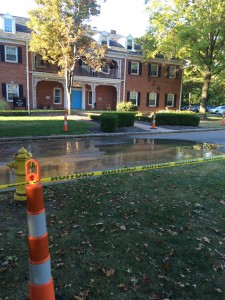
Students and faculty evacuated the Schimmel-Conrades Science Center on the afternoon of Oct. 27 due to an overheated drying oven in a botany-microbiology department lab.
There were never any flames, just a lot smoke, according to David Johnson, professor of botany-microbiology.
The smoke set off the fire alarms throughout the building which led to the evacuation and the arrival of Public Safety and the Delaware City Fire Department. Faculty and students remained outside for about 45 minutes until the problem was cleared.
“I think we all knew it wasn’t a very big incident but it did cause quite a large commotion,” said junior Brenna Peterson, a student in the Organisms and their Environment class that was using the oven at the time.
The class could not resume after re-entering the building due to the volume of smoke that still remained in the room, but senior Nick Fowler said Johnson led them on an impromptu hike to salvage some of the lessons.
The lab had been using the oven to dry out soybeans when they became aware of a scorch smell and turned off the oven Johnson said.
However, later in the afternoon smoke began to come out of the exhaust hole, filling the classroom with smoke and setting off the alarms.
“I think what seems to have happened was there was a short in the electrical system so the thermostat wasn’t working anymore,” Johnson said.
After the fire department arrived and contained the situation, the drying oven which resembles a giant box, was placed on a cart and wheeled out of the building.
Johnson said the department will most likely replace the oven, as this one was 10 years old and blackened on the inside. He said it cost $1,000 when the department bought it and he expects a new one to be around the same price.
If a new oven is acquired, it will probably not arrive until next semester, which could disrupt several labs this semester.
There had been no issue with the oven in the past, Johnson said.
–30–













